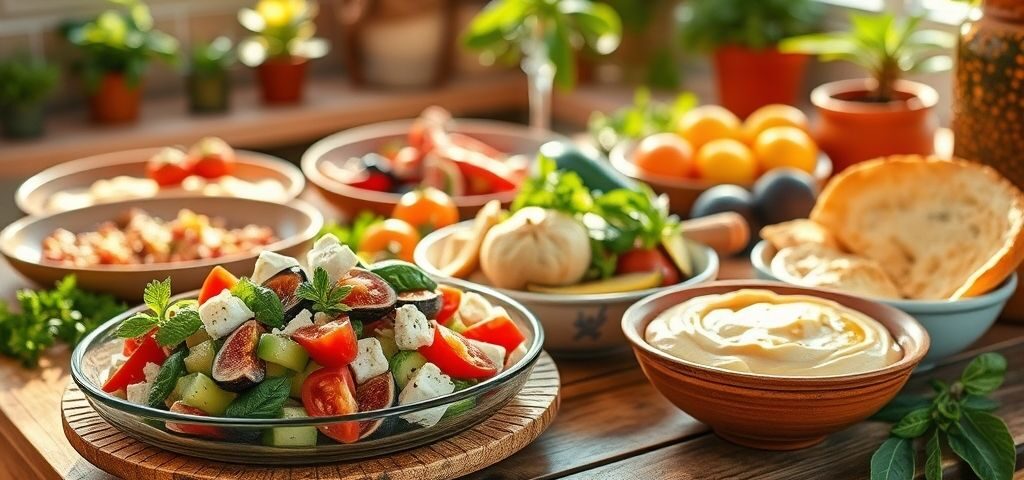Looking for a delicious and heart-healthy way of eating? The Mediterranean diet has been ranked as one of the best diets in the world for years, praised for its ability to improve heart health, support weight management, and even promote longevity. Mediterranean Diet Meal Plan
But what does a Mediterranean diet look like in everyday life? Let’s dive into a sample Mediterranean meal plan that’s easy, flavorful, and packed with wholesome ingredients.
MY BLOG: { Mediterranean Diet Meal Plan}
What Is the Mediterranean Diet?
The Mediterranean diet is inspired by the traditional eating habits of countries bordering the Mediterranean Sea, such as Greece, Italy, and Spain.
It focuses on:
✅ Lots of fresh fruits and vegetables
✅ Whole grains like quinoa and brown rice
✅ Healthy fats from olive oil, nuts, and seeds
✅ Lean proteins like fish, beans, and legumes
✅ Minimal red meat and processed foods
Think of it as a plant-forward lifestyle, with seafood and olive oil as stars of the show.
Health Benefits of the Mediterranean Diet
Before we jump into the meal plan, here’s why doctors and nutritionists rave about it:
Improves heart health by lowering bad cholesterol
Supports a healthy weight with nutrient-dense foods
Reduces inflammation in the body
Boosts brain health with omega-3-rich fish
Promotes longevity thanks to its antioxidant-rich foods
It’s not a “fad diet”—it’s a sustainable way of eating for life.
What Foods Are Included in a Mediterranean Diet Meal Plan?
Here’s a quick cheat sheet:
✅ Eat plenty of:
Vegetables & fruits
Legumes & beans
Whole grains
Nuts & seeds
Olive oil is the main fat
Fresh herbs & spices
Seafood & poultry in moderation
❌ Limit:
Butter & cream
Refined carbs & sugar
Processed snacks
Sample 1-Day Mediterranean Diet Meal Plan
Here’s what a typical day might look like on this diet.
Breakfast: Greek Yogurt Parfait
1 cup plain Greek yogurt
A handful of fresh berries (strawberries, blueberries, raspberries)
1 tablespoon chia seeds
A drizzle of raw honey
A sprinkle of walnuts or almonds
💡 Why it’s great: Packed with probiotics, fiber, and healthy fats to keep you full all morning.
Mid-Morning Snack: Fresh Fruit & Nuts
1 small apple or orange
A handful of mixed nuts (almonds, pistachios, or walnuts)
💡 Snack tip: Nuts provide heart-healthy fats while fruit adds natural sweetness.
Lunch: Quinoa & Chickpea Salad with Olive Oil Dressing
1 cup cooked quinoa
½ cup chickpeas
Chopped cucumber, cherry tomatoes, red onion, and spinach
A sprinkle of feta cheese
Dressing: Extra virgin olive oil, lemon juice, garlic, oregano
💡 Why it’s great: High in plant-based protein, fiber, and loaded with Mediterranean flavors.
Afternoon Snack: Hummus with Veggies
3 tablespoons hummus
Fresh veggie sticks: carrots, cucumbers, bell peppers
💡 Snack tip: Hummus (made from chickpeas) is rich in protein and healthy fats.
Dinner: Grilled Salmon with Roasted Vegetables
4–6 oz grilled salmon seasoned with olive oil, lemon, and herbs
Roasted zucchini, eggplant, and bell peppers drizzled with olive oil
½ cup brown rice or whole-grain couscous
💡 Why it’s great: Omega-3-rich salmon supports brain and heart health, while roasted veggies keep it colorful and nutrient-packed.

Evening Treat (Optional): A Square of Dark Chocolate & Herbal Tea
1–2 squares of 70% dark chocolate
A cup of chamomile or mint tea
💡 Why it’s great: Dark chocolate is rich in antioxidants and herbal tea aids digestion.
Want a 3-Day Mediterranean Meal Plan?
Here’s a quick look:
Day 1:
Breakfast: Whole-grain toast with avocado & poached egg
Lunch: Lentil soup with side salad
Dinner: Grilled shrimp with couscous and spinach
Day 2:
Breakfast: Oatmeal with berries & almonds
Lunch: Tuna salad with olive oil & chickpeas
Dinner: Lemon herb chicken with roasted potatoes
Day 3:
Breakfast: Smoothie with spinach, banana & Greek yogurt
Lunch: Falafel wrap with tahini sauce
Dinner: Baked cod with quinoa and steamed veggies
Tips for Following the Mediterranean Diet
Use olive oil as your main cooking fat instead of butter.
Flavor with herbs & spices instead of heavy sauces.
Swap refined carbs for whole grains like quinoa, bulgur, or farro.
Eat fish at least twice a week.
Enjoy meals socially—the Mediterranean lifestyle values eating together!
Is the Mediterranean Diet Expensive?
Not necessarily! You can keep it budget-friendly by:
Buying seasonal produce
Choosing frozen fish and veggies
Cooking at home instead of eating out
Using beans and lentils as affordable protein sources

Conclusion
The Mediterranean diet isn’t just a way of eating—it’s a lifestyle focused on fresh, whole foods, healthy fats, and mindful eating. A typical meal plan includes plenty of colorful vegetables, lean proteins like fish and beans, hearty whole grains, and flavorful herbs and spices.
It’s simple, satisfying, and backed by science for long-term health benefits.
So, if you’re looking for a delicious, sustainable diet, the Mediterranean approach is a perfect choice!
FAQs About the Mediterranean Diet
Can you eat pasta on the Mediterranean diet?
Yes, but choose whole-grain pasta and pair it with lots of veggies and olive oil.
Is wine allowed on the Mediterranean diet?
Yes, in moderation—typically a small glass of red wine with dinner.
Can vegetarians follow the Mediterranean diet?
Absolutely! Focus on beans, lentils, tofu, and lots of plant-based meals.
How often should you eat fish on the Mediterranean diet?
At least 2–3 times per week for optimal heart health.
Is the Mediterranean diet good for weight loss?
Yes, it can aid in sustainable weight loss, as it emphasizes whole, nutrient-dense foods.

